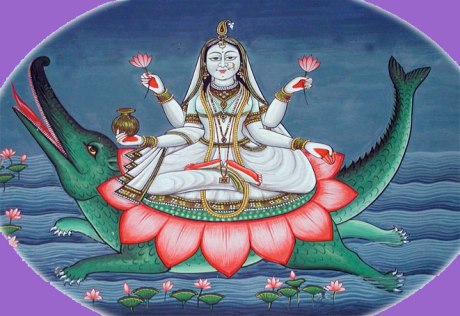 The Ganga defines our history and mythology. She is the merciful receiver of all sins. She is the source and end of all prayers. On her banks both life and death find meaning. She is the janeu of India, the thread that knits life and death. – Ravi Shankar
The Ganga defines our history and mythology. She is the merciful receiver of all sins. She is the source and end of all prayers. On her banks both life and death find meaning. She is the janeu of India, the thread that knits life and death. – Ravi Shankar
Yesterday was the last Sunday of September, the day for celebrating the rivers of the world. In Hinduism, the river is a metaphor for ancient, sacred tides of karma along which the soul travels to reach the shore of liberation. And the Ganga is the water of life.
A river runs through every Indian. The river of Hindusim is different from Hindutva and its political urgency. It is a mystic flow of liberation that celebrates the beauty of the Vedas and the Upanishads, which contain the essence of man. It does not distinguish between new faiths and the Original Faith, since it knows there is only One—the faith that salutes the Blue God, who presides in fierce meditation over the Himalayas and from whose matted locks surges India’s most sacred river.
The Ganga defines our history and mythology. She is the merciful receiver of all sins. She is the source and end of all prayers. On her banks both life and death find meaning. She is the janeu of India, the thread that knits life and death.
Sa eva kushalo janah pranamatiha bhagirathim
Sa eva tapasam nidhirjapati janhavim adarat
Sa eva purushottamah smarati sadhu mandakini
Sa eva vijayi prabhuh surataranginim sevate
(It benefits one who offers obeisances to the Ganga. He is a great ascetic, one who faithfully chants her names. By meditating on her one becomes the best of all people. The person who serves the Mandakini (Ganga) is always victorious, and is considered the master of everyone.)
The Ganga is everything to everyone. The mother of rivers. Her water is regarded as amrit, the nectar of the gods. Its power subsumes other beliefs. History records that Emperor Akbar was never seen without Ganga jal. The sailors of the East India Company only drank Ganga water on their three-month return journey to England, because it was always “sweet and fresh”. And the Ganga also offers salvation after death.
However, the Ganga herself is dying. The World Wildlife Foundation has marked the Ganga as one of the most endangered rivers in the world. The Mahakumbh, one of India’s holiest of festivals, is held on the banks of the Ganga (and the Yamuna) in Allahabad, where hundreds of thousands of pilgrims come to wash their sins away.
In May 2016, they walked bewildered across the dry river bed, searching for her embrace. The floods came three months later, affecting four million people and displacing 6.5 lakh from their homes. The Ganga’s aquatic life is endangered by reckless pollution that pours industrial poison into her. The balloning population of the cities along her banks disgorges their excreta into her—once riverside cities were divine destinations. Since 1985, six billion rupees have been wasted on the Ganga Action Plan.
Her sisters are dying, too. Jaggi Vasudev Sadhguru estimates that 25 per cent of India is becoming a desert. In 15 years, water supply will be reduced by half. Last year, most of the Godavari was dry. The water-flow of the Kaveri is down by 60 per cent. The Krishna and Narmada have lost around 60 per cent.
Ancient belief says mornings are blessed by chanting the Gayatri Mantra half immersed in a river, paying obeisance to life-giving sun. In a few decades, the waters of our dying rivers will be so polluted to bathe or drink from. The mythological arteries of India’s eternal faith will become history. And the soul of Hinduism will run dry forever. – The New Indian Express, 24 September 2017
» Ravi Shankar is a columnist for The New Indian Express in New Delhi.
Source: https://bharatabharati.wordpress.com/2017/09/25/ganga-is-everything-to-everyone-the-mother-of-rivers-ravi-shankar/







